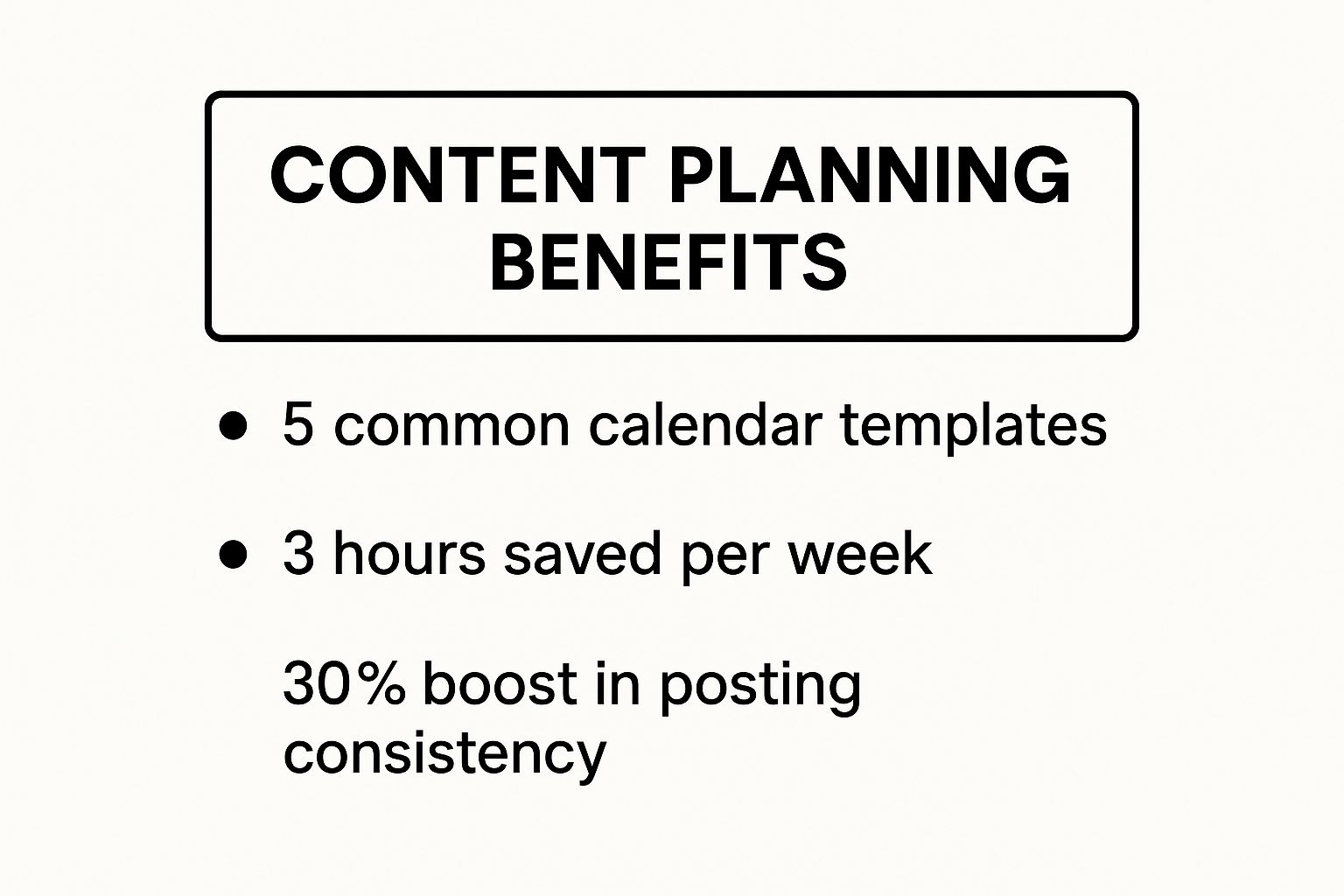Boost Your Strategy with a Content Calendar for Marketing

Why Smart Marketers Rely on Content Calendars

In the fast-paced world of digital marketing, a content calendar is essential. It acts as a roadmap, guiding your content creation and ensuring a consistent online presence. Instead of sporadic, unplanned posts, a content calendar allows for a strategic and consistent approach. This organized system transforms reactive scrambling into proactive planning.
Benefits of Using a Content Calendar
A content calendar helps marketers maintain a consistent publishing schedule. This consistency is key for building audience engagement and establishing a reliable brand presence. Imagine a brand regularly posting valuable insights, then disappearing for weeks. This inconsistency can damage credibility and decrease follower engagement. A content calendar prevents these issues.
A content calendar also facilitates better team collaboration. It acts as a central hub, clearly outlining deadlines, responsibilities, and the overall content strategy. This transparency keeps everyone aligned, streamlining workflows and improving communication. This shared visibility minimizes confusion and promotes efficient content development.
Furthermore, content calendars are crucial for resource management. They allow you to effectively allocate team members, balance workloads, and optimize resource utilization. By visualizing the entire content pipeline, you can identify potential bottlenecks and adjust accordingly. This proactive approach prevents team overload and maximizes productivity.
Content calendars are especially important with the rise of content marketing. By 2025, an estimated 82% of companies will incorporate content marketing into their strategy. A well-planned calendar allows businesses to align their messaging with cultural moments, seasonal trends, and customer interests, boosting marketing effectiveness. This highlights the growing importance of a structured content approach.
From Scheduling to Strategy: Maximizing Your Content Calendar
Content calendars aren't just for scheduling; they're for strategically aligning content with overall marketing objectives. They help ensure a diverse mix of content formats, catering to different audience preferences and covering various stages of the customer journey. This strategic balance maintains audience engagement and drives desired results. This leads us to the next crucial step: developing a robust framework for your content calendar.
Building Your Marketing Calendar Framework
What separates a truly effective content calendar from a simple to-do list? It's the underlying framework. This section breaks down the essential components of a content calendar that drives results, transforming it from a basic scheduling tool into a strategic asset for your marketing efforts.
Key Elements of an Effective Content Calendar
A robust content calendar needs more than just dates and titles. It should be the central hub for all content-related information, facilitating smooth collaboration and efficient execution. Think of it as the project manager for your entire content operation.
To ensure your content calendar includes all the necessary information, consider the following elements:
- Content Topic/Title: A clear, concise description of the content.
- Content Format: Specify the type of content: blog post, video, infographic, social media update, etc.
- Target Audience: Identify the specific audience segment you want to reach.
- Keywords: Incorporate relevant keywords for SEO purposes.
- Author/Owner: Assign responsibility for content creation and ensure accountability.
- Due Date: Set internal deadlines for each stage of content development.
- Publish Date: The planned date and time for content to go live.
- Platform/Channel: Indicate where the content will be published (e.g., LinkedIn, Instagram, blog).
- Status: Track the progress of each piece (e.g., In Progress, Pending Review, Published).
- Call to Action (CTA): Define the desired action you want the audience to take.
Before diving into building your calendar, it's helpful to understand which elements are essential and which are optional based on your business size. The following table provides a comparison:
Essential Content Calendar Elements
A comparison of must-have versus optional elements for content calendars based on business size.
| Element | Small Business | Mid-Size Company | Enterprise |
|---|---|---|---|
| Content Topic/Title | Must-have | Must-have | Must-have |
| Content Format | Must-have | Must-have | Must-have |
| Target Audience | Must-have | Must-have | Must-have |
| Keywords | Must-have | Must-have | Must-have |
| Author/Owner | Must-have | Must-have | Must-have |
| Due Date | Must-have | Must-have | Must-have |
| Publish Date | Must-have | Must-have | Must-have |
| Platform/Channel | Must-have | Must-have | Must-have |
| Status | Must-have | Must-have | Must-have |
| Call to Action (CTA) | Must-have | Must-have | Must-have |
| Campaign Tracking | Optional | Must-have | Must-have |
| Budget Allocation | Optional | Optional | Must-have |
| Content Approval Workflow | Optional | Must-have | Must-have |
As shown in the table, while core elements remain consistent across all business sizes, larger organizations benefit from incorporating more advanced features like campaign tracking, budget allocation, and formalized approval workflows.
Choosing the Right Template for Your Needs
There's no one-size-fits-all content calendar template. The ideal choice depends on factors like team size, workflow, and the complexity of your content strategy. Experiment to find what works best.
Here are a few popular options:
- Spreadsheet Templates: Simple, affordable, and perfect for small teams or individuals. Tools like Google Sheets or Microsoft Excel offer easy-to-use spreadsheet functionalities.
- Project Management Software: Platforms like Trello, Asana, or Monday.com offer robust collaboration features, ideal for larger teams.
- Specialized Marketing Calendar Software: Tools like CoSchedule or HubSpot provide advanced features, including workflow automation and social media scheduling.

As this infographic illustrates, using a well-structured content calendar can lead to significant time savings and increased posting consistency. Teams using effective templates report saving an average of 3 hours per week and a 30% boost in consistent posting.
Building Flexibility into Your Framework
While structure is essential, your content calendar shouldn't be rigid. It needs to be adaptable. Build in flexibility to accommodate unexpected opportunities or shifting trends.
For instance, reserve space for timely content related to current events or trending hashtags. Regularly review and update your calendar to ensure alignment with your overall marketing objectives and target audience needs. This dynamic approach allows you to stay agile and maximize your content's impact.
Orchestrating Content Across Multiple Platforms

Creating a content calendar isn't just about scheduling. It's about understanding what each platform needs. A single piece of content rarely works perfectly everywhere. For example, a lengthy blog post requires adjustments for visual platforms like Instagram or TikTok. This means changing the length, tone, format, and visuals.
Tailoring Content for Different Channels
Successful brands know platform optimization is key. They keep their brand message consistent but tailor content to each channel's needs. This includes character limits, image ratios, and even algorithm preferences. It's like tailoring a suit: the fabric is the same, but the cut and fit change for each person.
Content calendars are also vital for optimizing content across these diverse platforms. Social media ad spending is expected to hit $276.7 billion by 2025, with a significant portion focused on mobile. This highlights the need for calendars that adapt to mobile users. More detailed statistics can be found here: Social Media Statistics.
Repurposing Content for Maximum Impact
Creating fresh content for every platform is time-consuming. This is where content repurposing shines. A content calendar lets you efficiently repurpose core content. A webinar, for instance, can become short video clips for social media, infographics highlighting key takeaways, and gated content on your website. This maximizes your core message's reach without starting from scratch every time. Learn more about repurposing in our guide on boosting your LinkedIn presence with various content types.
Maintaining Consistency Across Channels
Adapting content is important, but a consistent brand voice and message is equally vital. Your content calendar should guide the overall narrative. This ensures all content contributes to your marketing goals, regardless of the platform. This means developing content themes that resonate across multiple touchpoints while respecting each channel's audience. For example, a consistent theme can be a thought leadership article on LinkedIn, a quick tip video on Instagram, and an engaging poll on Twitter.
This coordinated approach maximizes reach and reinforces your brand message. It builds a stronger brand identity and a more unified experience for your audience. By strategically aligning content, you create synergy that drives engagement and strengthens your online presence.
Content Calendar Tools That Actually Work
Finding the right content calendar solution can be a challenge. This section simplifies the process, helping marketing teams evaluate tools that offer genuine value. We'll explore a range of options, from basic spreadsheet templates to full-fledged marketing platforms.
From Spreadsheets to Software: Choosing the Right Tool
The best content calendar tool depends on your team's workflow, budget, and content strategy's complexity. A small business with a simple blog strategy might find a spreadsheet sufficient. However, a larger team managing multiple campaigns across various platforms will likely need a more robust solution.
Spreadsheet Software: Free tools like Google Sheets and Microsoft Excel are accessible options for basic content calendars. They're flexible and user-friendly, particularly for small teams. However, spreadsheets can become cumbersome as content operations scale. Collaboration features are also limited.
Project Management Software: Platforms like Trello, Asana, and Monday.com offer visual workflows and enhanced collaboration, improving team communication and project tracking. They provide a valuable step up from spreadsheets for managing more complex content calendars.
Specialized Marketing Calendar Software: Tools like CoSchedule and HubSpot cater specifically to marketing teams, offering features like social media scheduling, workflow automation, and analytics integration. These platforms provide comprehensive solutions, but often at a higher cost.
To help you compare these different options, take a look at the table below:
Content Calendar Tool Comparison: Analysis of popular content calendar tools comparing features, pricing, and use cases.
| Tool | Best For | Key Features | Price Range | Learning Curve |
|---|---|---|---|---|
| Google Sheets | Individuals & Small Teams | Free, Flexible, Basic Collaboration | Free | Easy |
| Trello | Small to Medium Teams | Visual Workflows, Project Management | Free - Paid Plans | Easy to Moderate |
| Asana | Larger Teams & Complex Projects | Robust Project Management, Integrations | Free - Paid Plans | Moderate |
| CoSchedule | Marketing Teams | Social Media Scheduling, Workflow Automation | Paid Plans | Moderate to Advanced |
| HubSpot | Marketing Teams | Comprehensive Marketing Platform, Analytics Integration | Paid Plans | Moderate to Advanced |
As you can see, the best tool for you will depend on your specific needs and budget. Consider factors like team size, required features, and ease of use when making your decision.
Evaluating Content Calendar Tools
When choosing a content calendar tool, consider these key factors:
Ease of Use: The tool should be intuitive and easy for your team to learn, maximizing productivity.
Collaboration Features: Effective team communication is essential. Look for features like task assignments, notifications, and shared calendars.
Integration Capabilities: Seamless integration with your existing platforms, like your CRM, social media accounts, or analytics dashboards, is crucial.
Scalability: The tool should be able to grow with your team and content operations.
Pricing: Find a tool that balances features and affordability within your budget.
Automation and Integration for Efficiency
Dedicated content calendar software offers valuable automation capabilities. For example, some tools allow automatic social media posting, saving time and ensuring consistent publishing. Integration with other marketing tools streamlines workflows, providing a complete view of your marketing efforts. This can involve connecting your content calendar to your analytics dashboard for performance tracking and future planning.
This combined automation and integration allows your team to focus on strategic tasks, like content strategy development and audience engagement. Choosing the right content calendar tool empowers you to work smarter, not harder. If you're struggling with content creation, a free Content Calendar Generator can be a helpful starting point.
Connecting Calendar Planning to Marketing Objectives

A content calendar is more than just a scheduling tool. It’s a strategic roadmap that directs your content towards achieving specific business goals. This elevates it from a simple list of deadlines to a dynamic asset that drives your marketing strategy forward.
Mapping Content to the Customer Journey
Understanding the customer journey is crucial for effective content planning. Successful brands tailor their content to each stage of this journey.
- Awareness: In this initial phase, content like blog posts and social media updates can attract potential customers by offering industry insights or addressing common pain points.
- Consideration: As customers begin to explore solutions, product-focused content, such as webinars or case studies, becomes more effective in showcasing your offerings.
- Decision/Loyalty: Nurturing customer relationships and driving conversions in these later stages often involves personalized emails, exclusive offers, and testimonials.
Balancing Time-Sensitive and Evergreen Content
A well-structured content calendar balances time-sensitive content with evergreen material.
- Time-Sensitive: This content, often tied to specific promotions or events, generates immediate engagement and drives short-term results. Think about a limited-time offer or a product launch announcement.
- Evergreen: Addressing timeless topics relevant to your industry, evergreen content provides long-term value. This type of content consistently attracts organic traffic and establishes your brand as a thought leader. A comprehensive guide or a how-to article would be a good example.
This blend caters to both immediate needs and sustained growth. For more insights on long-term content planning, check out this resource on How to master your LinkedIn content strategy.
Distributing Content Types for a Balanced Mix
A diverse content mix is key to engaging your audience and achieving your business goals. Consider these different content types:
- Promotional: This content highlights product features and special offers, directly driving sales.
- Educational: Building trust and positioning your brand as an expert resource is often achieved through educational content, such as how-to videos or informative blog posts.
- Engagement-Focused: Content designed to foster community and strengthen brand loyalty can include interactive polls, Q&A sessions, or contests.
Balancing these types ensures a well-rounded approach. A free Content Calendar Generator can be a helpful tool to get started.
Regularly Reviewing Your Content Calendar
Regular reviews are essential for maintaining an agile content strategy. Analyzing performance data, assessing market trends, and incorporating team feedback allows for continuous optimization. This iterative process ensures your content calendar remains a dynamic and effective tool for driving business growth. By adapting to changing conditions, you can maximize your impact and consistently achieve your marketing objectives.
Using Analytics to Power Your Content Calendar
The most effective content calendars aren't built on guesswork. They're driven by data. Savvy marketing teams leverage performance insights to continuously refine their content planning. This transforms their calendars from static documents into dynamic, adaptable tools.
Identifying Key Performance Indicators (KPIs)
Before diving into the data, determine which key performance indicators (KPIs) matter most to your goals. Different content necessitates different metrics. For example, blog posts might prioritize organic traffic and lead generation, while social media posts emphasize engagement and reach. Choosing the right KPIs provides focus and ensures you measure what truly counts.
Analyzing Content Performance Data
Once you've identified your KPIs, analyze historical data. Look for patterns in your content's performance. Which topics resonated most with your audience? Which formats drove the most engagement? What times of day did your posts perform best? Uncovering these trends offers valuable insights for future content planning. For instance, if your audience consistently prefers video content over text, your calendar should reflect that preference.
Actionable Insights and Calendar Adjustments
Analyzing data isn't enough. You need to translate insights into actionable changes. If data reveals that long-form articles drive more traffic than short blog posts, dedicate more calendar space to that format. Perhaps certain topics consistently underperform. This suggests a need to shift focus to more relevant themes. These adjustments ensure your content calendar aligns with what your audience actually wants. You might be interested in: 10 Proven Content Repurposing Strategies to Boost ROI.
Creating a Feedback Loop
Establish a feedback loop between content creation and planning. Regularly review your content calendar against its performance. Are your chosen KPIs improving? If not, what needs adjusting? This continuous evaluation ensures your content calendar remains a dynamic, evolving tool. Treat it as a living document that adapts and improves over time. Integrating your content calendar with your overall marketing objectives is crucial. Consider your overall marketing strategy.
Avoiding Analysis Paralysis
While data is essential, avoid analysis paralysis. Don't get bogged down in excessive metrics. Concentrate on the most impactful KPIs. Use data to inform decisions, not dictate them. The most effective content calendars find a balance between data-driven insights and creative intuition. This balanced approach allows you to create content that resonates with your audience while achieving your marketing objectives.
Future-Proofing Your Content Calendar Strategy
The marketing world is in constant flux. New platforms appear, audience tastes evolve, and algorithms shift. This means your content calendar for marketing needs to be adaptable and dynamic to remain effective. Planning is essential, but the ability to adjust and evolve is even more crucial.
Think of your content calendar as a roadmap, not a rigid itinerary. It provides direction but allows for detours and adjustments based on the evolving marketing landscape. It's about finding the right balance between proactive planning and reactive flexibility. A solid foundation is key, but the ability to build upon it in different directions is just as important.
Embracing Adaptability in Your Content Planning
Building adaptability into your content strategy is crucial for long-term success. This involves shifting from rigid adherence to plans and embracing flexibility. This doesn't mean abandoning planning altogether. Instead, it’s about strategically responding to the changing dynamics of the digital realm.
Having a flexible approach allows you to capitalize on new opportunities and mitigate potential risks. This adaptability ensures that your content remains relevant and effective in the face of ongoing change. It's about being prepared for the unexpected and having the agility to pivot as needed.
Incorporating Emerging Content Formats
New content formats are constantly appearing. From short-form videos on platforms like TikTok to interactive polls on Twitter, the possibilities are always expanding. Your content calendar should be designed to accommodate these emerging formats.
This means allocating time for experimentation and being open to trying new things. If a new platform gains traction, your calendar should allow you to test content specifically designed for that platform. Exploring various formats is vital to discover what resonates best with new audiences. This experimentation keeps your content fresh and relevant.
Responding to Algorithm Changes
Social media algorithms are known for their unpredictable nature. A change in the algorithm can dramatically affect the reach and engagement of your content. This requires constant monitoring and the ability to adapt quickly. Your content calendar should be a living document, not set in stone.
Regularly review and adjust your strategy based on algorithm updates. This might involve modifying posting frequency, experimenting with different content formats, or focusing on particular keywords. Staying informed and being responsive is crucial for maintaining visibility.
Adjusting to Shifting Audience Preferences
Audience preferences evolve just as platforms and algorithms do. What engaged your audience a year ago might not be effective today. Therefore, continuous audience analysis is critical. Use data and feedback to understand how your audience interacts with your content.
Consider questions like: Are they engaging more with video content or written posts? Which topics are generating the most interest? Use these insights to adjust your content calendar accordingly. By understanding your audience, you can ensure your content remains relevant and engaging.
Designing an Evolving Content Calendar System
Consider your content calendar a living document, constantly evolving to meet new demands. Here are some tips for building a future-proof content calendar system:
Modular Content: Create content that can be easily repurposed for different platforms and formats. This provides greater flexibility and efficiency.
Flexible Scheduling: Don't overschedule. Leave room for timely content related to trending topics or unforeseen events.
Regular Reviews: Set a regular schedule for reviewing and updating your content calendar. This ensures it stays aligned with your overall goals.
Performance Tracking: Integrate analytics into your content calendar process. Use data to understand what’s performing well and where adjustments are needed.
By incorporating these elements, your content calendar transforms into a dynamic tool that adapts and thrives in the constantly changing marketing landscape. Ready to elevate your visual content? Lumeo can help you create stunning and engaging visuals. Discover how Lumeo can transform your posts into high-impact visual assets.